|
|
|
|
Later this week I will be launching my most ambitious forum project to date.
As many of you know, those that have been around the forum for some years as I have, I have a passion for history especially military history, as well as building models.
There is a lot of interest in WW1 at the moment and it is clear that us model builders have a lot of interest in it too. For me the First World War is one of the most misrepresented and misunderstood wars of the last 300 years. A combination of propaganda, political posturing post war press misrepresentation and lazy historians has produced a much distorted view of the war.
So As July is the month that a June assassination became a global conflagration I am going to begin a 4 year project to reassess the war each month in this forum. This won’t be like ‘this day in history’ it will be a monthly instalment discussing the events of 100 years ago that month. I also intend to link this to our hobby by sharing links to models that represent events and even touch on model building history as we go, did you know there was a Great War 'part work' series 100 years ago?!!
This will be unique to Model Space not a load of internet posts cobbled together, this will be my view taken from my research. I hope you all find it interesting and take something away from it.
My first post will be at some point this week when I will look at the outbreak of war and deal with the popular misconception that war happened because war was wanted.“Whenever you find yourself on the side of the majority, it is time to pause and reflect.”
-Mark Twain
|
|
|
 Rank: Super-Elite        Groups: Registered
Joined: 31/05/2010 Posts: 5,679 Points: 17,011 Location: Wiltshire
|
Jase That sounds like a very interesting project you have lined up there and I am sure it will generate a whole lot of interest. Happy modelling Tony Happy Modelling
BUILDING: Hachette Spitfire Mk 1A, Constructo Mayflower
SUBSCRIPTION COMPLETE (Awaiting building): USS Constitution, Sovereign of the Seas, 1:200 Bismarck (Hachette)
COMPLETED: Porsche 911, E-Type Jaguar, Lam Countach
|
|
|
 Rank: Vice-Master    Groups: Registered
Joined: 26/05/2014 Posts: 912 Points: 2,773 Location: East Sussex UK
|
sounds like a plan Jase, i will certainly be looking out for it. Building: DelPrado HMS Victory. Building: DeAgostini Sovereign Of The Seas.
|
|
|
|
|
Thanks Both  “Whenever you find yourself on the side of the majority, it is time to pause and reflect.”
-Mark Twain
|
|
|
|
|
I studied Politics and Contemporary History at the University of Salford and specialised in military history, at that time one of the two best courses in that country. I recall my professor saying there was a difference between understanding the facts and understanding the fact. By this he meant that the facts are always the same but its interpretation can anything to anybody. And that is all history is, interpretation of the facts. For example many people believe that the German Army that took Paris and pushed the BEF back across the channel was the most advanced army in the world at the time and army could have stopped them. Well the facts are this, The french had the largest army in the world, the British the only Fully mechanised army in the world. The germans were inferior in both numbers and equipment and could have been stopped but their strategies and tactics were far superior to the allied forces. German propaganda was full of Stukas, Tanks and the like and the german people believed they had a strong modern Army, After Dunkirk It suited the British government to have the people believe the german Army was ultra modern and un stoppable - it deflected from the truth - the facts and that is the basis of these articles.
The First World war past from living memory only recently, and so it is only recently that historians, professional or amateur, can now truly evaluate the events. To understand History you can not be connected to it. Its not possible to be truly objective if the events in some way are connected to you emotionally. My Great great Uncle died in a dressing station at the Somme. I have visited his grave and been to the battlefields of 1914-18 and i am emotionally attached to this war - but i will do my best.Silence Silence, that is how the Great War began. Not the sound of squabbling emperors as the marxists might have you believe or evan the shot that took the life of Archduke Franz Ferdinand, heir to the Austro-Hungarian throne, in Sarajevo on 28 June 1914 as most School books will tell you.
The first global war, the war to end all wars, the Great War or World War 1 if you prefer, began with the most defining silence in history. In number 10 Downing street in a dimly lit smoke filled room there was no a sound. a small collection of the cabinet waited for a knock, a knock on the door that would end the biggest game of political chicken imaginable. The silence was broken buy the sound of Big Ben ringing out 11 O,clock that was the moment that would change the world forever and would create the modern Britain we know today. The knock so desperately awaited was to come from the telegraph operator awaiting a response to Britain's ultimatum to Germany to withdraw her troops from Belgium. Germany did not reply and at midnight the operator sent Berlin the message GN (good night).
For me that it the definitive moment that Europe and the world found itself at war. All the events that transpired between the shot in Sarajevo and Berlin ignoring the British ultimatum were stepping stones but, at each one disaster could have been avoided. popular belief is that in some way the combination of pacts and alliances amongst european countries made war inevitable. or even that politicians wanted war the the various imperial head of states relished the idea of war and just did not expect the trench warfare that followed; and all of that is just rubbish!!
The British King, the German kaiser and the Russian Tsar were all family. Non of them wanted war indeed the Kaiser begged the British king to try and influence the political events in the UK and halt the move to war. The truth is that although Europe in 1914 was a collection of Empires, Imperial rule was all but symbolic even in Russia it was the political advisers that were influencing the decisions of the Tsar. This was not an imperialist war it was not the war that destroyed imperialism Political representation of the people was well established by 1914.
The war was political, our and simple. the assassination was an excuse for political groups to act. it was the excuse that they were looking for. Franz Ferdinand was not well liked even by his own people and so was no brat loss but it was enough for Austria-Hungary to implicate the Serbian government in the assassination and claims they had links with the black hand gang who had committed the assassination (something not proven to this day)
It took three weeks for the reaction a contrived political opportunity by the Austria-Hungary government to stamp its authority upon the Serbians, crushing the nationalist movement there and cementing Austria-Hungary's influence in the Balkans. The back drop to this was 3 Balken wars during 1912 and 1913.
Sir Edward Grey, the British Foreign Secretary described the ultimatum that effectively nullified Serbia's sovereignty as 'a document of formidable character'. Austria-Hungary's expectation was that Serbia would reject the remarkably severe terms of the ultimatum, allowing the trigger for a limited war against Serbia.
Serbia had slavic ties with Russia, Austria-Hungry knew this but expected nothing more than some diplomatic cross words. The fact is that pacts did not hold the same international clout they do today. there was no global morality to judge a nation. pacts were diplomatic tools and could be applied or not as was seen fit. That said Austria-Hungry turned to its friend the merging industrial power eager to build its own empire for assurances of support if the 'unthinkable' happened and war with Russia became a reality, Germany readily agreed.
Austria-Hungary, declared war on Serbia on 28 July 1914. This was the first stepping stone but still only a minor local war.
Russia, bound by treaty to Serbia, announced mobilisation of its vast army in response. Russia had recently been given a surprise bloody nose by Japan and politicly this was a statement of strength. It would take 6 weeks to mobilise the Russian army and the war could well be done by then. this stepping stone was a political gamble with limited perceived risk.
Russia underestimated German resolve. Germany, allied to Austria-Hungary by treaty, viewed the Russian mobilisation as an act of war and declared war on Russia on 1 August. the expectation ate this stepping stone was that this may just be enough to hold up Russia while Astro-Hungry concluded its business.
France, suddenly found itself at war against Germany due to a pact with Russia and declared war on Germany on 3 August.
Germanys response was swift. It invaded neutral Belgium in an attempt to flank the French forces and capture Paris by the shortest possible route in the quickest possible time, Ideally before Russia could mobilise. This was the tipping point the point of escalation. until now everything had been political posturing the waving of papers to try and influence the other to back down. All of it deliberate political actions by the respective governments.
Britain, had a "moral obligation" rather than a pact with France, but that was not really the trigger for Britain. Britain was obligated to defend neutral Belgium by the terms of a 75-year old treaty, even so the Belgian King still had to appeal to Britain for assistance. Britain committed herself to Belgium's defence later that day, 4th August and issued Germany an ultimatum to withdraw its troops from Neutral Belgium or find itself at war with the British Empire.
And so came the silence Britain found itself at war and like France she was by extension also at war with Austria-Hungary. Europe was at war because there had been no real political will to stop it. With Britain came the Empire Australia, Canada, India, New Zealand and the Union of South Africa all were at war too all pledging to fight by Britain's side. European war had become world war. The USA declared neutrality. Italy found wording within its pacts with both Austria-Hungary and Germany to allow itself to wriggle out of the war and also declared neutrality, for now. Finally Japan entered the war on the 23rd August declaring war on Germany honouring a military agreement with Britain.
At every step the political leaders hoped their action would be enough to avoid war but each action escalated the war. An on going balkan unrest and a Germany keen to flex its imperial muscle had lead to a global conflict nobody wanted.
Model making
In this part each month i will try and reference models either available kits or famous models at museums that are related to the events i will be discussing.
This time i want to talk about Partworks. Model Space is a forum that supports models built in a partwork format. The idea being you can spread the cost and lessen the impact on your cash flow. But originally this concept was used by publishers of books, most of Charles Di*kens books were available as weekly partworks. for the printer this gave a regular cash flow and for the reader the opportunity to purchase at a smaller cost and so it gave a wider readership, win win for all.
With the outbreak of the Great War the publishers were quick to use this format to report the war. Once such company was the Amalgamated Press ltd and their weekly publication 'The War Illustrated. A pictorial record of the conflict of the nations' The format we would recognise a weekly magazine that could be bound in binders. it was hugely popular and contained images of the fighting. articles from famous writers such as H.G.Wells diagrams and explanations of new technology such as submarines and maps of the conflict as well as a good dose of patriotic propaganda. It is interesting to read through these and see how the publication changes over the years. more pages of pictures of the fallen. More pictures of the depravity of the Hun and increasing racial attacks. none the less it is an invaluable record of events. These are two of my copies.
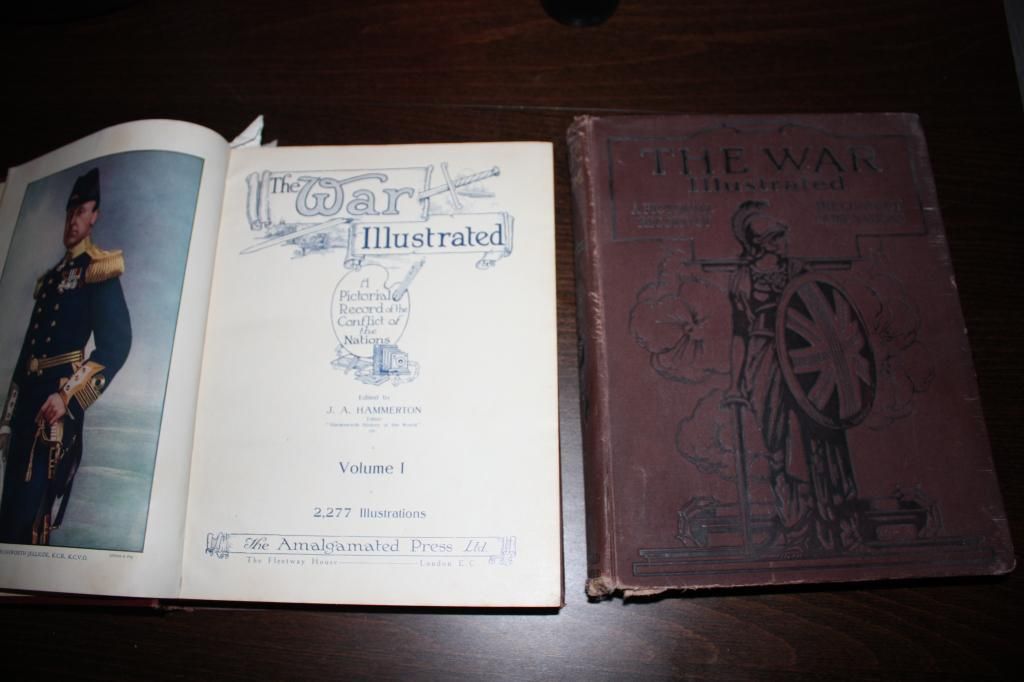 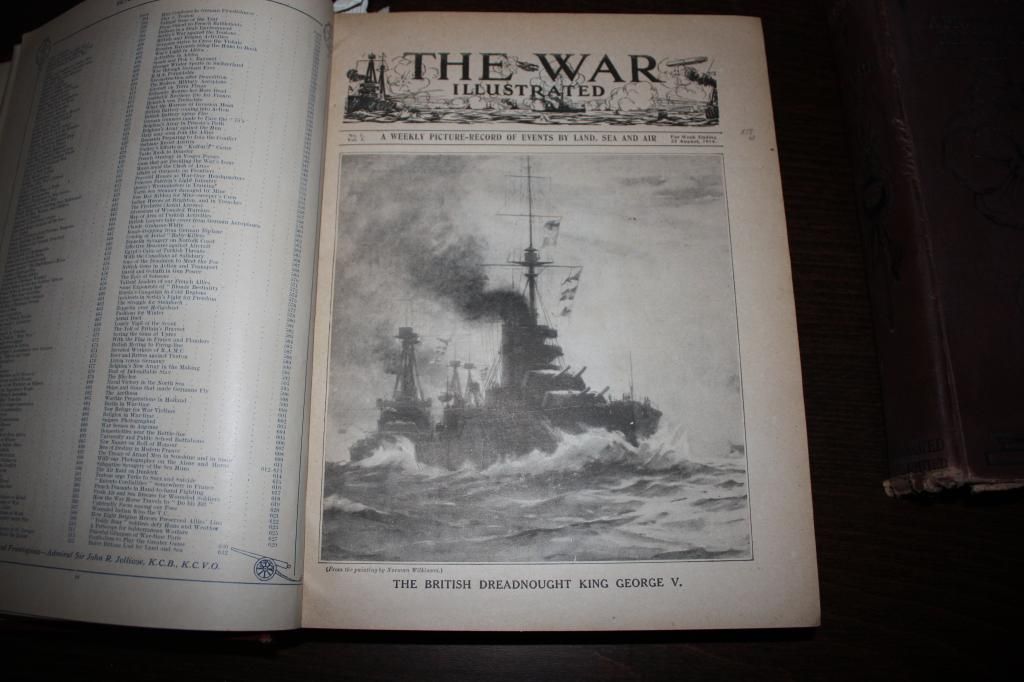 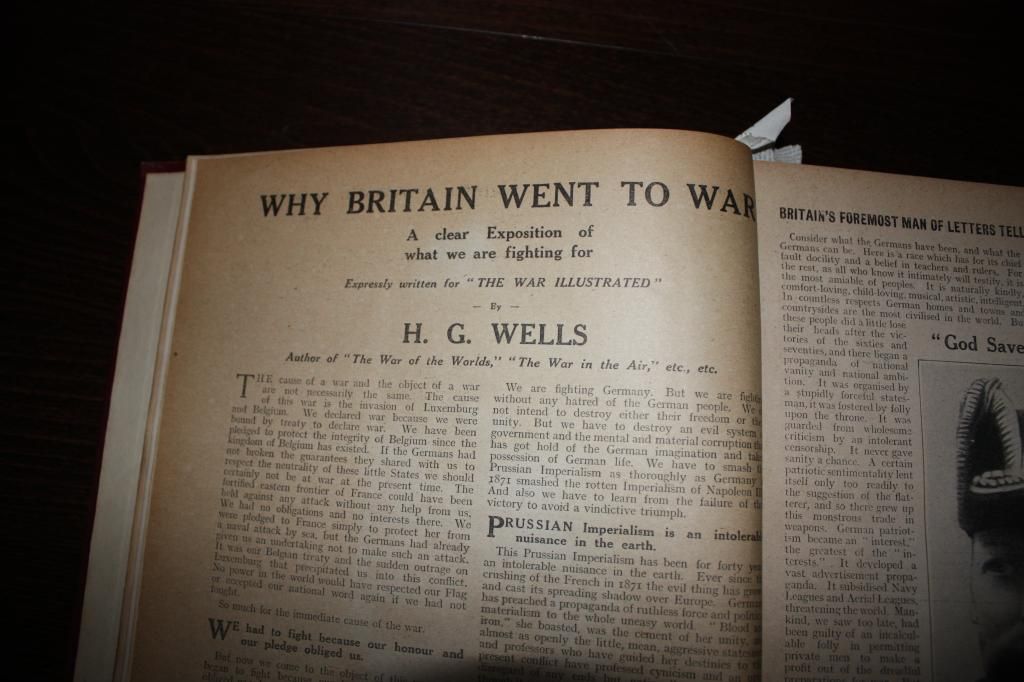 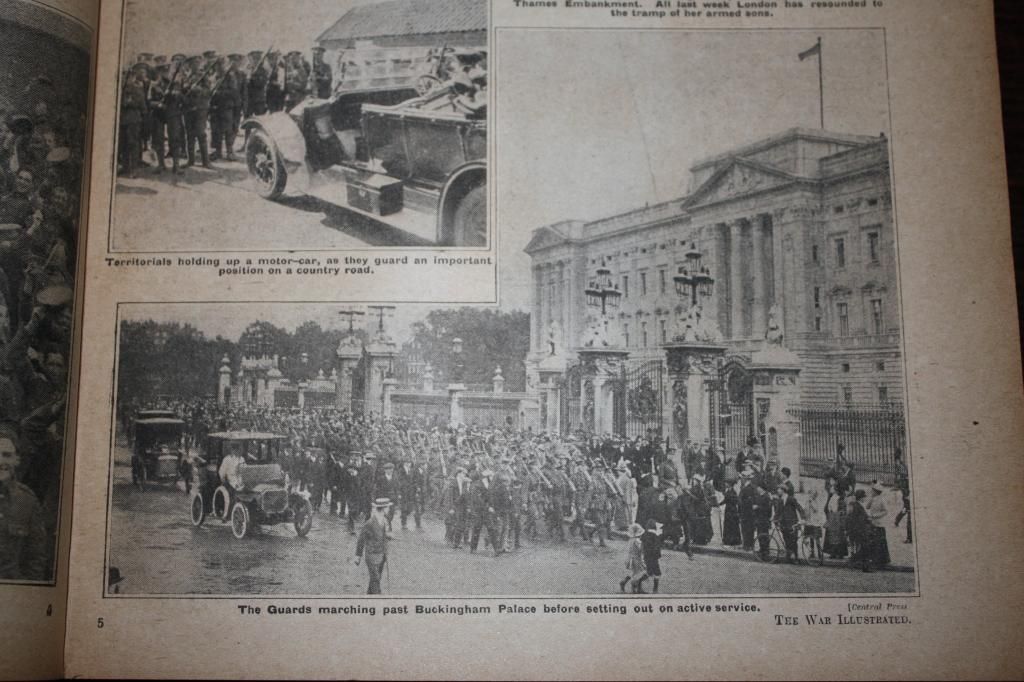 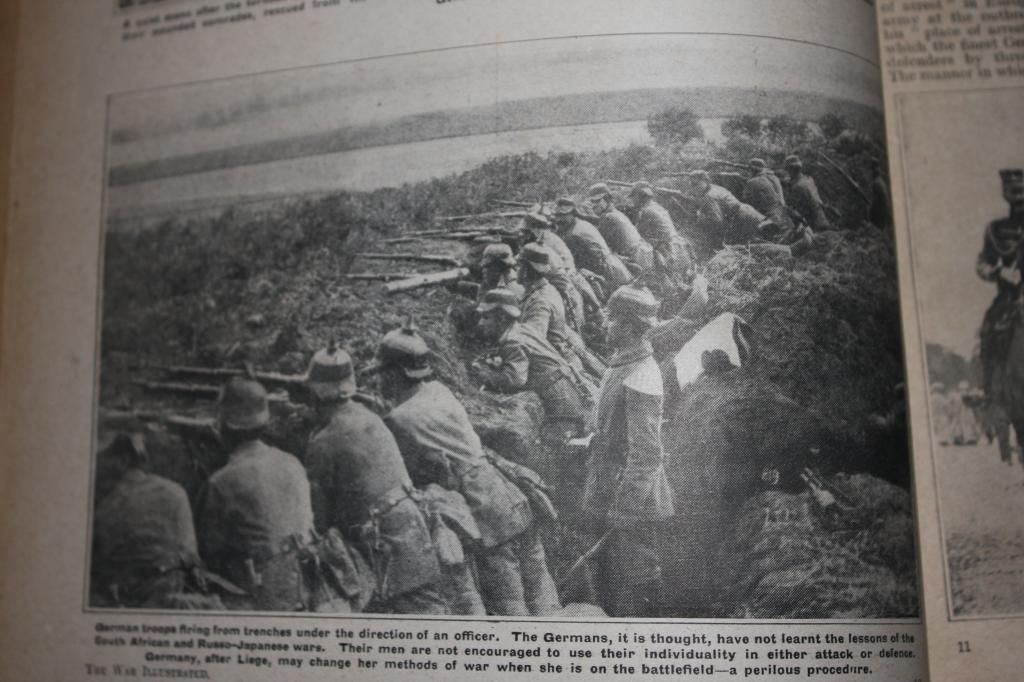  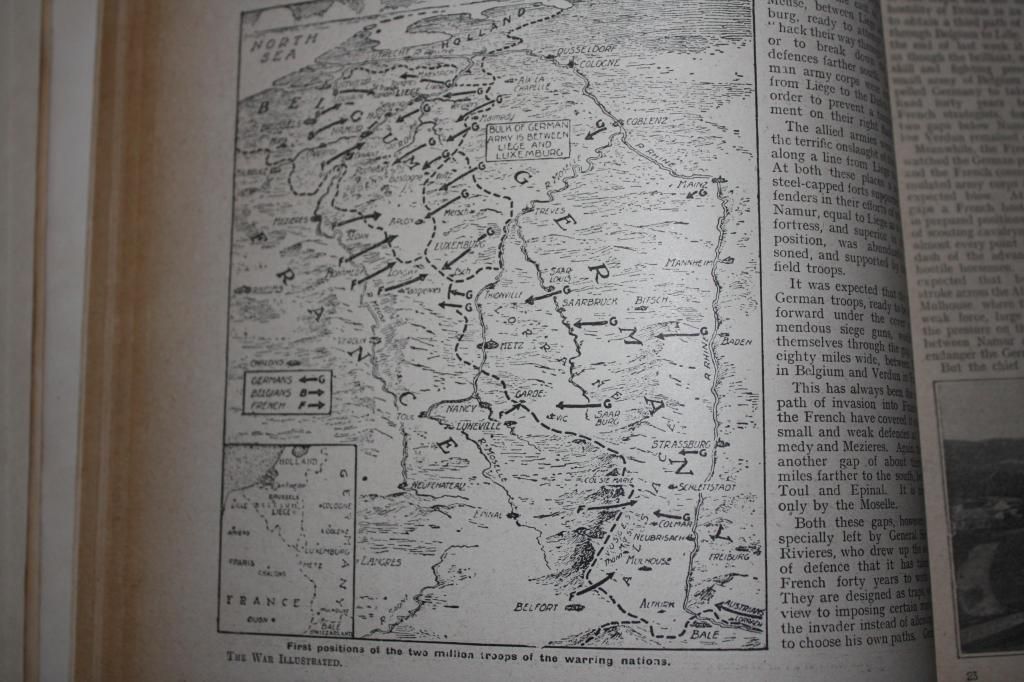 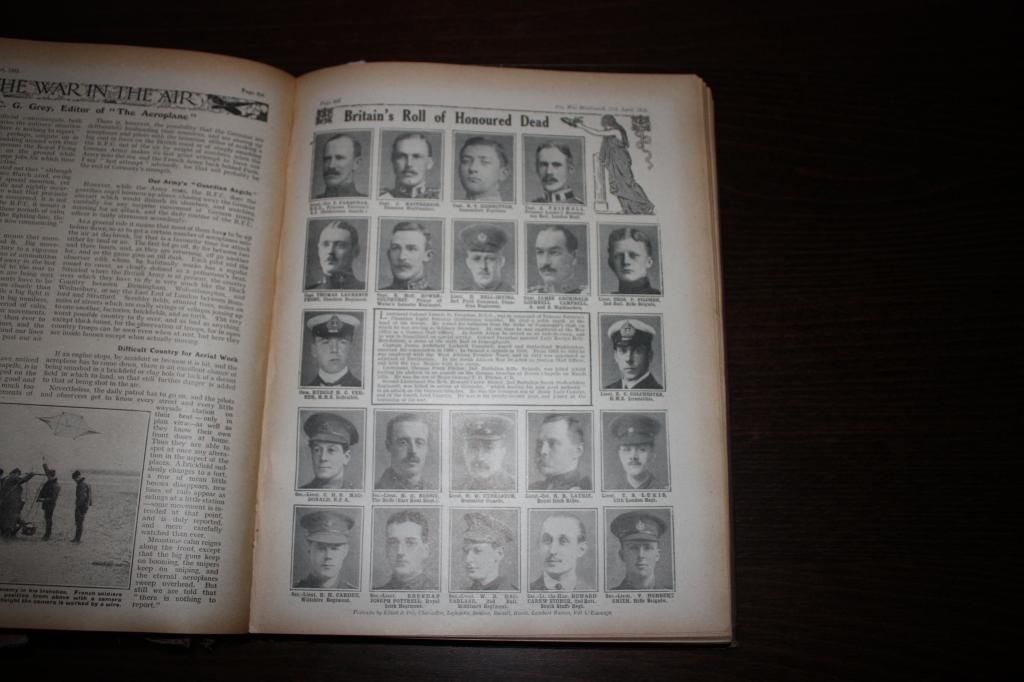 “Whenever you find yourself on the side of the majority, it is time to pause and reflect.”
-Mark Twain
|
|
|
|
|
Jase, a fascinating and educational read... think I'm going to really enjoy your articles and perhaps increase my historical knowledge along the way.... A great idea that I'm sure will be eagerly followed by a lot of members.... Credit to you for adding something very different to the forum..... Very, very well done.....   Regards Alan
|
|
|
|
|
Gandale wrote:Jase, a fascinating and educational read... think I'm going to really enjoy your articles and perhaps increase my historical knowledge along the way.... A great idea that I'm sure will be eagerly followed by a lot of members.... Credit to you for adding something very different to the forum..... Very, very well done.....   Regards Alan Thank you Alan. As long as there is an interest to follow I will post. Jase “Whenever you find yourself on the side of the majority, it is time to pause and reflect.”
-Mark Twain
|
|
|
 Rank: Super-Elite        Groups: Registered
Joined: 31/05/2010 Posts: 5,679 Points: 17,011 Location: Wiltshire
|
Jase Been looking forward to seeing how you start this one off as it could certainly generate some different views. All I can say is very well done Sir this is really interesting and I really do,like the modelling element you are adding. Wondering if that old part works had their own version of Mr T? If they did wonder what he looked like? Well done again Jase - looking forward to your ongoing updates on this very important and interesting period of history. Kind regards Tony Happy Modelling
BUILDING: Hachette Spitfire Mk 1A, Constructo Mayflower
SUBSCRIPTION COMPLETE (Awaiting building): USS Constitution, Sovereign of the Seas, 1:200 Bismarck (Hachette)
COMPLETED: Porsche 911, E-Type Jaguar, Lam Countach
|
|
|
|
|
birdaj2 wrote:Jase
Been looking forward to seeing how you start this one off as it could certainly generate some different views.
All I can say is very well done Sir this is really interesting and I really do,like the modelling element you are adding. Wondering if that old part works had their own version of Mr T? If they did wonder what he looked like?
Well done again Jase - looking forward to your ongoing updates on this very important and interesting period of history.
Kind regards
Tony many thanks Tony no doubt a 100 year old MR t would have sported a rather nifty moustache and no doubt whittling a model ship from scrap wood and horse bones   “Whenever you find yourself on the side of the majority, it is time to pause and reflect.”
-Mark Twain
|
|
|
|
|
100 years ago at 11pm European leaders lost hope that somebody would back down and pull Europe back from the brink of war. Whilst the politicians waited in silence the German army busted itself in preparation for its next move. To move swiftly through Belgium and push on to Paris the German army under General Emmich and his force of 30,000 men needed to open a crossing of the Meuse River. Between success and failure stood a ring of 12 forts built in 1880 and a force of 70,000 men of General Leman's forces. So began the first battle of the Great War the 12 day long Battle for Liege.
To be continued...
“Whenever you find yourself on the side of the majority, it is time to pause and reflect.”
-Mark Twain
|
|
|
|
|
August 1914.Before we can start to explore the military events of the Great War it is necessary to re-set our perspective. Last month I described the basic political events the triggered the war. Most general history books will treat this as the first chapter and then focus on the military events levying the politics and politicians largely behind. This is a mistake that both simplifies and distorts our understanding. In essence the military are the strong arm of foreign policy. Military objectives are set by politicians the use of weapons are authorised by politicians the development of weapons is set by politicians. Military leaders make the decisions on how to apply the resource they have to achieve the political aim they have been set. it is important to hold that fact close to us when we see the application of Gas, tanks, aerial bombing and to an extent the wiping of the map of civilian settlements across the front lines; all is lead by the politicians. So if we accept that everything we see described about the Great War is rooted in politics we have a more complex but more clear and understandable foundation to build our understanding on.
To further build on this we need to understand the relationship between the military and government in 1914. To do this I would like to fast forward us in time to Nuremberg 1946. The war crimes trials the followed the end of the second world war in Europe changed our perspective on the relationship between government and military. For the first time Law was applied to say that everybody in the armed forces had a moral obligation to uphold not just military codes and conventions but also to consider if political direction was right or wrong. Up until that point military leaders not following political direction were committing a criminal act - treason. Nuremberg blurred that line and so the stock 'only following orders' was no longer a defence. But in 1914 no such interpretation had been applied. The basis of the Nuremberg trial for those leaders of the armed forces was that they should have said no, they should have mutinied they should have revolted and deposed the political leadership of the country. So in 1914 the military of all the combatant nations was expected to be disciplined and do as it was told - it was expected to just follow orders. that is not to say there was not healthy debate about political decisions because there was but for the military to say no no more fighting it would need the backing of the people. This happened later in the war in Russia but across the british Empire throughout the war was never unpopular with the people until the 1920s. the simple fact is massacre in no manes land the misery of trench warfare and the use of poison gas happened and was maintained because there was a political will to do so.
Battle and Siege of Liège
The Battle and Siege of Liège began on 5th August and is widely accepted as the first military action of the Great War. 34 divisions of the Imperial german Army were amassing on the German lines, poised to move into Belgium. In total, seven German armies some 1.5 million men. These men were to put into practice the long held
Schlieffen Plan, a sweeping advance through Belgium into France created by the former German Chief of Staff Alfred von Schlieffen. Field Marshal Karl von Bulow easing up the 2nd Army had orders to take the city of Liège. Liège was built on top of a steep slope sweeping up from the Meuse river. it was the key crossing point and was defended by 12 forts circling the city 6 each side of the river roughly 3 miles part and was probably the most heavily fortified area of Europe at that time.
Bulow had 320,000 troops at his disposal, Liège was defended by a garrison of 35,000. Six brigades, commanded by General Otto von Emmich were charged with taking Liège while the rest of the german army amassed. Bulow believed Belgian resistance would me of little significance. However King Albert had urged his people to fight for their independence at all costs and the Belgan defenders held fast in a valiant defence, much to the shock of the German army. After a day of fighting non of the forts defending Liège had fallen. One German brigade eventually succeeded in breaking the line of forts and the Germans entered the city on 7th August after attacks on it by a Zeppelin airship, the first arial assault of the war. But the fighting continued, from 12th - 16th August the Germans bombarded the forts with its heaviest artillery. 9 Skoda built 12-inch siege cannons known as "skinny emma" and the 2 massive 16.5 inch cannons known as "Big Bertha" built by Krupp. Up until this point the largest cannon fired was 13.5 inches by the Royal Navy. it took a further 3 days to take 12 forts and capture the belgian General Gerard Mathieu Leman. Later he would write from his prison cell to King Albert that "I would gladly have given my life, but Death would not have me.", he had been found unconscious. The way was cleared for the German advance which began 3 days later on the 18th August.
"Our advance in Belgium is certainly brutal," these are the words of German Chief of Staff Helmuth von Moltke. From the first day in Belgium the German forces had taken a firm line with the civilian population. German propaganda had firmly stated that civilians could not be trusted and that priests were part of a resistance network. Civilians were shot from day one and priests hunted down. In total, German troops killed 5,521 civilians in Belgium and 896 in France, earning Germany the hatred levelled at it by the allies during the rest of the war. The courageous resistance of the Belgian army and its defiant king brought international respect and helped to justify the worthy cause for the Allied nations.
Attempt to Liberate Alsace.
The opening french move was not to protect its boarder or that of the belgian border from the german invasion. it was the politically charged attempt to retake Alsace, which had been in german hands since 1871. On the 7th August French troops crossed the boarder into Alsace in an attempted to capture Mulhouse and liberate the province of Alsace from its German occupation. Mulhouse was an important industrial city on the banks of the river Rhine. The battle of Mulhose raged from the 8th to the 25th August. the city changed hands twice and each time was recaptured by German forces of the 7th Army. For the french it was a matter of pride.
http://www.britishpathe....-lorraine-recaptured-by
But the french advance was also part of its defensive plan. Several battles were fort along the french border now collectively called The Battles of the Frontiers. fighting occurred at the battles of Morhange, Sarrebourg and Mortagne. German strategy was clever and well prepared. the oil and coal rich area was an obvious objective for the french and the germans deliberately allowed the french forces to advance to keep the french distracted from the main german advance through Belgium. When it came the prepared german counter attack was devastating tacking many thousands of casualties.
The French encountered a numerically superior German force in the Fourth and Fifth Armies dug into defensive positions within the forests of the Ardennes region. The Germans had dug in and prepared well with with heavy artillery pieces and machine guns. The attacking French soldiers were not at all prepared, poorly trained in defensive tactics and dressed for a set piece open field battle in dark blue jackets and red pantalon trousers, which highlight their positions in the wooded terrain. The French attacks were cut down with heavy casualties. The french had been outmanoeuvred outclassed and were outnumbered after a few days of fighting the French had no option but to withdraw to the towns of Verdun, Stenay and Sedan.
Capture of Namur
By the third week of August the German Second and Third Armies pushed on to the south-west along the Meuse river. The Belgian city of Namur lay at the junction of the Sambre and the Meuse rivers. Also a fortified town the German siege cannons were quickly brought up and made short work of the fortifications. The french had managed to get just one regiment to aid its defence but it was not enough and by the 25th Namur had fallen.
Charleroi
The Battle of Charleroi only lasted a couple of days between the French Fifth Army and the German Second and Third Armies. The french had attempted to halt the german advance after the fall of Namur but again the Germans were more than a mach and the french went int general withdraw.
Mons
The Battle of Mons on the 23rd August was a major battle amongst the Battles of the Frontiers and was the first encounter between British and German forces on the Western Front. The British Expeditionary Force (B.E.F) had landed at the French coast on 16th. Now the British force of four infantry divisions and a cavalry division from the First Army was advancing through northern France to close on the Sambre river and take up the left flank of the French fifth Army. Reaching Mons on 22nd August the B.E.F. encountered German patrols at Soignies, which were advancing spearhead of the German First Army. The Following day the British cam under attack from the german forces that outnumbered the british 2 to 1. However General von Kluck found the British forces to be a different calibre of those encounter so far. the highly trained British infantry caused significant casualties due to its superior rifle fire. Non the less recognising the German superiority in both men and artillery the British were withdrawn from Mons with orders to maintain the line with the retreating French Armies on the right flank. The retreat became a fighting rearguard action and on the 26th August the british fought a standing battle at Le Cateau.
With the British and French now retreating south to the Oise river. The French attempted to halt the german advance again with a counter attack, the battle of Guise on 29th. The objective was to halt the german advance and hold the line north of the Oise river. Again the French found themselves unable to halt the German advance and was forced to retreat sour back across the Oise and destroying the brides as it pulled back.
After just over three weeks of fighting in the first month of the war the combined German, French and British forces had sustained around 300,000 casualties. The better prepared German forces had largely been successful and the planed advance on Paris was looking realistic. In effect the British and french were in retreat and the German army was moving quickly to keep up the pressure and prevent time to regroup. with out doubt the Germans had received a couple of surprise hold ups but in effect the german advance was well prepared and going to plan.
August 1914 Timeline
In this section each month I will list the various other events within the month not described above.
4th August
German warships "Goeben" and "Breslau" bombard Philippeville and Bona respectively.
Secret Alliance between Germany and Turkey signed at Berlin.
British Grand Fleet constituted under Admiral Sir John Jellicoe.
Staff of British Expeditionary Force appointed
5th August
Montenegro declares war on Austria-Hungary
Minelaying in the open sea commenced by the Germans. German minelayer "Königin Luise" sunk.
First meeting of British War Council
6th August
Austria-Hungary declares war on Russia.
Serbia declares war on Germany
Field-Marshal Earl Kitchener succeeds Mr. Asquith as Secretary of State for War, Great Britain.
H.M.S. "Amphion" sunk by mine off Yarmouth.
Naval Convention between France and Great Britain concluded in London. French Admiral to command Allied Naval Forces in the Mediterranean.
Action between H.M.S. "Bristol" and German cruiser "Karlsruhe" in the West Indies.
Admiral von Spee's squadron leaves Ponape "Scharnhorst" (flag), "Gneisenau" and "Nürnberg."
7th August
Action between H.M.S. "Gloucester" and the "Goeben" and "Breslau" off the coast of Greece
8th August
British forces cross frontier of Togoland and occupy Lome (see 13th and 26th).
Swiss Government order Mobilisation.
H.M.S. "Astræa" bombards Dar es Salaam
9th August
British aerial cross-Channel patrol for the protection of transports instituted.
Belgian Government proposal for neutralisation of African free trade zone formulated (see 22nd).
H.M.S. "Birmingham" sinks German submarine "U.-15" in the North Sea. (First submarine destroyed.)
10th August
British aerial coast patrol established.
France severs diplomatic relations with Austria-Hungary.
11th August
German warships "Goeben" and "Breslau" enter the Dardenelles .
12th August
Great Britain and France declare war on Austria-Hungary.
Austrian forces cross the Save and seize Shabatz.
13th August
Austrian forces cross River Drina and begin first invasion of Serbia.
Four squadrons Royal Flying Corps fly from Dover to France. (First units to cross by air.)
14th August
Proclamation issued by Russian Commander-in-Chief (The Grand Duke Nicholas) promising autonomy to Poland
Battles of Morhange and Sarrebourg begin.
15th August
Japanese Government send ultimatum to Germany demanding evacuation of Tsingtau
German troops cross frontier of British East Africa and occupy Taveta
Junction of British and French squadrons effected at entrance to the Adriatic.
16th August
Naval action in the Southern Adriatic: Austrian light cruiser "Zenta" sunk by Allied squadron.
17th August
Battle of the Tser and the Jadar (Serbia) begins
Belgian Government transferred from Brussels to Antwerp
18th August
Battle of the Gette in Battle for Antwerp.
Vossuq ed Douleh, Persian Foreign Minister, resigns.
19th August
Belgian Army retreats from the Gette on Antwerp.
First unit of Indian Expeditionary Force "C" leaves India for East Africa
Ala es Sultaneh, Persian Prime Minister, resigns and is appointed Foreign Minister
Mustaufi ul Mamalek appointed Persian Prime Minister.
20th August
Brussels occupied by German forces
Battle of Gawaiten-Gumbinnen.
Death of Pope Pius X.
21st August
Battle of Charleroi begins.
Battle of the Tser and the Jadar ends. Austrian Armies in Serbia retreat.
German forces from German South-West Africa cross frontier of British South Africa
British Government issue orders for the raising of the first New Army of six Divisions
22nd August
Austria-Hungary declares war on Belgium.
Battle of the Ardennes begins.
German Government agree to Belgian proposal, made through Spanish Government, re African free trade zone
23rd August
German airship "Z.-8" shot down in the Vosges.
Battle of Tannenberg begins
First Battle of Krasnik (Poland) begins.
Germany severs diplomatic relations with Japan.
Japan declares war on Germany.
General C. M. Dobell appointed to command Allied land forces operating in the Cameroons.
General von Hindenburg takes over command of German Eighth Army
24th August
Battle of Charleroi ends
Battle of the Ardennes ends
Austria-Hungary severs diplomatic relations with Japan
First units of Indian Expeditionary Force "A" leave India for France
25th August
Battle of Malines begins
Valenciennes taken by German forces
Battle of the Mortagne (Vosges) begins
First use of aircraft for patrol purposes (over retreating British forces in France).
First Battle of Krasnik (Poland) ends
Shabatz retaken by Serbian forces. Last Austrian forces recross the Drina End of First Austrian invasion of Serbia
Japan severs diplomatic relations with Austria-Hungary
Japan declares "State of War" with Austria-Hungary.
Nigerian frontier of the Cameroons crossed by British forces.
Chad frontier crossed by French forces.
26th August
Louvain sacked by German troops.
Noyon taken by German forces
Longwy capitulates to German forces
Cambrai occupied by German forces
Douai occupied by German forces
First Battle of Lemberg (Galicia.) begins
Battle of Zamosc-Komarow begins
Naval action off the Aaland Islands. German cruiser "Magdeburg" destroyed by Russian squadron.
German forces in Togoland capitulate to the Allied forces
Action between H.M.S. "Highflyer" and German armed merchant cruiser "Kaiser Wilhelm der Grosse" off the Rio de Oro: latter sunk
General Galliéni appointed Governor of Paris
M. Messimy, French Minister for War, resigns
M. Delcassé succeeds M. Doumergue as French Foreign Minister.
27th August
British Marines landed at Ostend, accompanied by R.N.A.S. unit.
Lille occupied by German cavalry
Mezières occupied by German forces
M. Millerand appointed French Minister for War
First attack on Mora (Cameroons)
28th August
Austro-Hungarian declaration of war received by Belgian Government
Naval action off Heligoland (German light cruisers "Köln", "Mainz", and "Ariadne" sunk by British squadron).
29th August
Arras evacuated by the French forces
First Battle of Guise begins
Sedan taken by German forces
German airship "Z.-5" brought down by gunfire at Mlawa (Poland).
30th August
Laon, La Fère, and Roye occupied by German forces
First Battle of Guise ends
First German aeroplane raid on Paris
First Battle of Lemberg (Galicia) ends
Samoa occupied by New Zealand Expeditionary Force.
31st August
Amiens entered by German forces
Battle of Tannenberg ends
Franco- British Agreement defining provisional zones in Togoland concluded
Model making
If you are interested in capturing some of the events of August 1914 then you may find these links to relevant models of interest.
Big Bertha Paris Museum - http://en.wikipedia.org/wiki/Big_Bertha_(howitzer)#mediaviewer/File:Musee-de-lArmee-IMG_0984.jpg
Zepelin kit http://airalex.homestead.com/ZEPPELIN.html
SMS Goeben - http://www.steelnavy.com/NNTGoebenFirst.htm
Kaiser Wilhelm der Grosse
http://i-am-modelist.com...ser-wilhelm-der-grosse/
http://www.amazon.co.uk/...r-Wilhelm/dp/B003BJTERM
http://bob.plord.net/Shi...many/KaiserWilhelm.html
SMS Scharnhorst
http://www.freetimehobbies.com/CG3507FH/
SMS Nurnberg
http://www.freetimehobbi...man-light-cruiser-1914/
HMS Gloucester
http://www.freetimehobbi...ter-light-cruiser-1910/
Austrian troops
http://www.wonderlandmod...an-artillery-crew-mode/
http://www.hobbyeasy.com...c9b9jxwsxjxrrdi2nd.html
http://www.hobbyeasy.com...egxlwailyyfdyvgel5.html
French troops
http://www.1001modelkits...ench-infantry-54mm.html
http://www.emodels.co.uk...valry-8273-p-44715.html
http://www.hobbyeasy.com...hwmrhuo3ukzhskghcv.html
German troops
http://www.anticsonline....k/1286_1_105162144.html
http://www.wonderlandmod...es-172-wwi-german-army/
“Whenever you find yourself on the side of the majority, it is time to pause and reflect.”
-Mark Twain
|
|
|
|
|
Jase, a fascinating and educational read..... Some beautiful models of the period have also been well picked out by you..... You have obviously done your research to cover the months of July/Aug and I found it very enlightening.... A 4 year project covered month by month is a massive project to take on but believe your love of military history will make it very enjoyable for both you and the members of MS..... Well done...
Regards
Alan
|
|
|
|
|
Gandale wrote:Jase, a fascinating and educational read..... Some beautiful models of the period have also been well picked out by you..... You have obviously done your research to cover the months of July/Aug and I found it very enlightening.... A 4 year project covered month by month is a massive project to take on but believe your love of military history will make it very enjoyable for both you and the members of MS..... Well done...
Regards
Alan
Thanks Alan. A day a month is manageable so not so big a workload. first and last months are the busiest though. jase “Whenever you find yourself on the side of the majority, it is time to pause and reflect.”
-Mark Twain
|
|
|
 Rank: Vice-Master    Groups: Registered
Joined: 26/05/2014 Posts: 912 Points: 2,773 Location: East Sussex UK
|
Thanks Jase, most informative, and extremely well written, looking forward to the next installment. Paul Building: DelPrado HMS Victory. Building: DeAgostini Sovereign Of The Seas.
|
|
|
|
|
Gibbo wrote:Thanks Jase, most informative, and extremely well written, looking forward to the next installment.
Paul Many thanks Paul. just gauging interest at the moment to see if it is worth the effort. but if people are interested ill keep doing it J “Whenever you find yourself on the side of the majority, it is time to pause and reflect.”
-Mark Twain
|
|
|
 Rank: Super-Elite       Groups: Registered
Joined: 27/01/2014 Posts: 5,060 Points: 14,980
|
Fascinating reading, thanks Jase
|
|
|
 Rank: Super-Elite        Groups: Registered
Joined: 30/01/2013 Posts: 4,604 Points: 13,607 Location: Monmouthshire UK
|
Nice post Jase, I for one appreciate the effort gone into this, keep it up  Steve
|
|
|
|
|
Well done Jase! This is going to be a truly fascinating story to follow and the link to available kits is a brilliant idea! I'll be following this one closely! Robin First wooden ship: The Grimsby 12 Gun 'Frigate' by Constructo Second: Bounty DelPrado Part Works Third: HMS Victory DelPrado Part Works 1/100 scale Diorama of the Battle of the Brandywine from the American Revolutionary War Diorama of the Battle of New Falkland (unfinished sci-fi), Great War Centenary Diorama of the Messines Ridge Assault Index for the Victory diary is on page 1
|
|
|
 Rank: Super-Elite        Groups: Registered
Joined: 31/05/2010 Posts: 5,679 Points: 17,011 Location: Wiltshire
|
Jase Very good indeed. Naughty though  posting the model links as there are so many I want  . You have really put some major effort into this and it's very well put together - a credit to you Happy modelling Tony Happy Modelling
BUILDING: Hachette Spitfire Mk 1A, Constructo Mayflower
SUBSCRIPTION COMPLETE (Awaiting building): USS Constitution, Sovereign of the Seas, 1:200 Bismarck (Hachette)
COMPLETED: Porsche 911, E-Type Jaguar, Lam Countach
|
|
|
|
|
Thank you everybody.
On the basis of that I will do a September post in a few weeks time
Jase“Whenever you find yourself on the side of the majority, it is time to pause and reflect.”
-Mark Twain
|
|
|
|
Guest
|